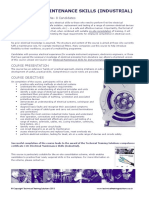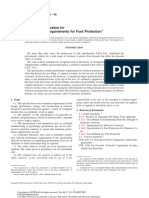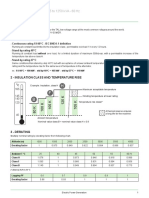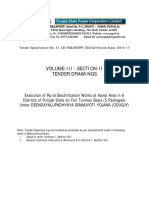Electrician Practical Skills Assessment Candidate Guide
Electrician Practical Skills Assessment Candidate Guide
Uploaded by
Saravanan RasayaCopyright:
Available Formats
Electrician Practical Skills Assessment Candidate Guide
Electrician Practical Skills Assessment Candidate Guide
Uploaded by
Saravanan RasayaCopyright
Available Formats
Share this document
Did you find this document useful?
Is this content inappropriate?
Copyright:
Available Formats
Electrician Practical Skills Assessment Candidate Guide
Electrician Practical Skills Assessment Candidate Guide
Uploaded by
Saravanan RasayaCopyright:
Available Formats
Electrician Skill Assessment
Candidate Guide
Published by VETASSESS, 2013
Copyright 2013 VETASSESS
All rights reserved. No part of this publication may be reproduced, stored in a retrieval system, or transmitted in any form or by any means, electronic, mechanical, photocopying, recording or otherwise.
UEE30811 Certificate III in Electrotechnology Electrician Skill Assessment Candidate Guide
How can I prepare for my practical assessment?
The following tips may help you to reduce anxiety during the assessment and perform at your best on the day. See the practical assessment as an opportunity to demonstrate what you know. Check the date, time and location of the assessment. Try to be rested prior to the assessment. Make sure you arrive on time. Listen carefully to all the assessor/ SME instructions. Ask the assessor/ SME to explain the task if you are unsure. Plan your time to do the best work you can, within the set timeframe. Remember relevant OH&S requirements including what PPE must be used. You cannot ask other candidates for help, hinder their assessments or use your mobile phone. Stay relaxed and positive during the assessment, have confidence in yourself and your skills. If you have any questions, ask your assessor/ SME.
What tools do I bring on the assessment day?
You are advised to bring at least your own hand tools (see list below) along on the practical assessment day. If you are unable to bring your own tools, VETASSESS will ensure tools are made available, but you may have to share these with other candidates. You may also choose to bring other tools which are not listed. Hand tools Pliers Screwdrivers (Phillips head and Flat shank) Side cutters Wire stripper or knife Tape measure or ruler Small spirit level Hacksaw or PVC conduit cutters Claw hammer Optional tools Long nose pliers Battery operated drill Drill set Screwdriver bits Bending spring for 20mm PVC conduit Meters IR Tester and leads Approved multi-meter and leads
Equipment Tag out / Lockout Kit
Page 3 of 8
V2 2013; VETASSESS
UEE30811 Certificate III in Electrotechnology Electrician Skill Assessment Candidate Guide
What do the practical tasks involve?
The following provides an overview of the types of activities you may be asked to perform for your Electrician practical assessment. Please note that this is SAMPLE ONLY. This is not a complete list and may change from time to time. Your assessor/ SME will provide you with details of the assessment activities on the day of your assessment.
Description of SAMPLE activities for Electrician Skills Assessment
From a given specification design, carry out and complete a functioning light and power installation within a specified time frame using safe working techniques including: Complete a Job Safety Analysis (JSA) Switchboard design and protection Test the installation and record results to verify compliance or non- compliance using a variety of test equipment. From circuit components symbols design, connect and fault find a direct on line (DOL) starter and three phase motor circuit including: Stop/start station, thermal overload, star-delta configuration, overload setting. As you complete the activities, your assessor may ask you questions. Write answers to questions on a variety of topics including, but not limited to: Electrical units and symbols Ohms Law calculations Single and three phase motors Impedance, inductive reactance, capacitive reactance calculations Power factor RMS values Magnetism, electromagnetism and transformer Calculate current, wattage, resistance and voltage in an ELV and LV single and three phase electric circuit Lighting Batteries Fire and Smoke detectors.
Perform a disconnect/ reconnect of electrical equipment using safe working procedures in a logical manner and test the disconnected equipment before reconnection. Carefully read the Safe Working Practice process and note the steps you must follow if you are to achieve a pass (See Attachment A). How do I complete my Elective? You will need to complete an Elective sheet. This sheet must show your recent work experience. You can do this by providing examples of electrical work you have carried out. This can be supported by also providing training certificates and reference documents.
Page 4 of 8
V2 2013; VETASSESS
UEE30811 Certificate III in Electrotechnology Electrician Skill Assessment Candidate Guide
Safe working practice for Electricians
The purpose of this Electrical Safe Work Practice is to provide basic procedures and guidance concerning proper personal protective equipment and the process for working on electrical systems. Ultimately, this Code of Practice attempts to reduce the number of accidents and losses associated with the operation, maintenance and repair of electrical equipment. A Code of Practice is a document made under the Australian Electrical Safety Act 2002. It gives practical advice on ways to discharge electrical safety obligations. Included in the Code are ways to identify and manage exposure to risks of injury and property damage caused, directly or indirectly, by electricity. At a place where electrical equipment is located, the Act imposes an obligation on an electrical worker: to comply with instructions for the electrical safety of persons and property at the place given: to the extent the instructions are consistent with instructions given by the person in control of the electrical equipment; to use personal protective equipment, if: the equipment is provided by the person in control of the electrical equipment for electrical safety purposes; and the worker is properly instructed in the use of the equipment provided; not to wilfully or recklessly interfere with or misuse anything provided for electrical safety at the place; and not to wilfully place any person, including yourself, at the place in electrical risk.
Personal Protective Equipment
Any electrical worker who works in/around energized equipment and has the potential to come into contact with "live" exposed parts must be provided and use Personal Protective Equipment (PPE). The following are basic guidelines for the proper use of electrical PPE. PPE should be used whenever you could come into contact with exposed electrical parts. Electrical Workers are required to wear electrically rated footwear at all times. PPE must be designed for the work being performed. You must make sure that electrical gloves, insulated tools, etc. are rated for the voltage levels they will be used around. Always inspect your electrical tools and PPE before each use to make sure they are in good condition and will work properly. If you find that a tool has been damaged, or that PPE has tears or holes, you need to replace the item before conducting the assigned work. You must wear eye and face PPE, such as face shield and safety glasses, whenever there is a possibility of electrical arcs or explosion. All test instruments and equipment (volt, ammeters, ohm meters) and associated leads, cables, power cords, probes, and connectors must be visually inspected for external defects and damage before the equipment is used.
Page 5 of 8
V2 2013; VETASSESS
UEE30811 Certificate III in Electrotechnology Electrician Skill Assessment Candidate Guide
Disconnection/ Reconnection procedure
The following table outlines the steps required to complete disconnection/ reconnection procedure on an item of electrical equipment. Note: Each step has points allocated and to achieve a pass, you must not lose more than 25 points. You will pass if you achieve 75 or more points. Testing the voltage tester for correct operation after use is critical when the candidate is going to touch the conductors/components on the belief they are de-energised. If you become aware of missing a step or making an error whilst carrying out the task please inform the assessor of this oversight
Disconnection Process Notify personnel you are going to start working. Check if removal of protective devices will affect essential services. Test voltage tester at known `LIVE source for correct operation before use. Ensure the frame of the equipment is not `LIVE by testing between frame/ chassis and the known earth. Test voltage tester at known `LIVE source for correct operation after use. Take operational details of appliance (e.g. kW and voltage). Take direction of rotation (DOR) of motor (where applicable) Complete details on danger tags (e.g. Name, date, fault, etc.). The equipment must also be tested for LIVE by either testing between all conductors including the protective earthing conductor or if a motor by starting it prior to isolating circuit conductors Affix danger tags to isolation points (e.g. appliance, isolating switch, switchboard, etc.). Do not leave exposed LIVE terminals/conductors at switchboard or equipment. Test voltage tester at known `LIVE source for correct operation before use. Before touching equipment conductors, test for LIVE! Test betweenall conductors and known earth. (This test also includes testing for LIVE between the protective earthing conductor and the known earth). Test betweenall conductors at the equipment end.
Mark Allocations/ Comments 1 point 1 point 2 points If this step is not carried out, you will not achieve a pass If this step is not carried out, you will not achieve a pass 3 points 3 points 5 points If this step is not carried out, you will not achieve a pass 3 points 5 points 2 points
If these 2 steps are not carried out, you will not achieve a pass
Page 6 of 8
V2 2013; VETASSESS
UEE30811 Certificate III in Electrotechnology Electrician Skill Assessment Candidate Guide
Disconnection Process Test Voltage Tester for correct operation on known LIVE source after using it. (Fail only occurs when previous test indicated terminals/conductors were deenergised). Determine location of appropriate protective device. Isolate protective device by applying lock-dog and lock or inserting dummy fuse wedge in fuse base. Terminate conductors in approved manner and enclose in junction box. Cable ends must be fully insulated. Affix Danger Tag to terminated conductors enclosed in junction box. Ensure terminated conductors are protected against mechanical damage. Clean up work area and notify personnel.
Mark Allocations/ Comments If this step is not carried out, you will not achieve a pass 2 points 3 points 2 points 3 points 2 points 1 point
Reconnection Process including Equipment Compliance Testing Notify personnel of return to work site. Ensure the appliance to be reconnected is of the same operational ratings (e.g. kW, amperes, voltage, etc.). Test Insulation Resistance and Continuity tester on both Meg Ohm (500V) and Ohm scale for correct operation. Carry out the insulation resistance test of the equipment. Test between all active and neutral conductors to the earth contact of the appliance. Carry out the continuity test of the equipment. Test between the earth terminal and frame of the equipment. Test voltage tester at known `LIVE source for correct operation before use. Before touching equipment conductors, test for LIVE! Test between - all conductors and known earth. (This test also includes testing for LIVE between the protective earthing conductor and the known earth.) Test betweenall conductors at the equipment end. Test voltage tester at known `LIVE source for correct operation after use. Reconnect final sub-circuit wiring to appliance terminals.
Mark Allocations/ Comments 1 point 2 points 3 points
If you fail to do this step, you will lose 15 points If you fail to do this step, you will lose 15 points 2 points
If these 2 steps are not carried out, you will not achieve a pass If this step is not carried out, you will not achieve a pass 1 point
Page 7 of 8
V2 2013; VETASSESS
UEE30811 Certificate III in Electrotechnology Electrician Skill Assessment Candidate Guide
Reconnection Process including Equipment Compliance Testing Carry out continuity test on final sub-circuit protective earthing conductor from effective earth to frame of appliance. (This test should be carried out after the circuit conductors have been connected to the equipments terminals and before the power ha s been restored). Notify personnel of restoration of power. Do not leave exposed LIVE terminals/conductors at switchboard or appliance. Remove lock, lock-dog and switch on circuit breaker or insert correct fuse wedge to restore power. Check appliance for correct operation (e.g. DOR [Direction of Rotation]) Clean up work area and notify personnel.
Mark Allocations/ Comments
If you fail to do this step, you will lose 15 points
2 points 3 points 1 point 3 points 1 point
Page 8 of 8
V2 2013; VETASSESS
You might also like
- 321.18.CR.0 NC Electrical Power Engineering 2018Document110 pages321.18.CR.0 NC Electrical Power Engineering 2018mufaro67% (3)
- Testing Electrical Equipment and CircuitsDocument7 pagesTesting Electrical Equipment and CircuitsJordan Leah100% (3)
- Electrical Test ProcedureDocument10 pagesElectrical Test ProcedureJay Anthony MorganNo ratings yet
- Goods Received Note - FormDocument1 pageGoods Received Note - FormSaravanan Rasaya70% (10)
- Magrini - Instrument Transformers For SM6Document45 pagesMagrini - Instrument Transformers For SM6muresan_paul100% (4)
- Electrician DACUM ChartDocument22 pagesElectrician DACUM Chartbehrooz100% (1)
- Checklist For Renewal of Registration As Safety and Health Officer (Sho)Document3 pagesChecklist For Renewal of Registration As Safety and Health Officer (Sho)Saravanan RasayaNo ratings yet
- Electrical Shop in A Ship Repair Yard PDFDocument21 pagesElectrical Shop in A Ship Repair Yard PDFBachhanChaubey100% (1)
- High Voltage Testing of GeneratorDocument28 pagesHigh Voltage Testing of GeneratorbuntysuratNo ratings yet
- Manual de Servicio Samsung MAX-X55!56!66Document44 pagesManual de Servicio Samsung MAX-X55!56!66Mauro Mangialavori0% (1)
- Electrical Installation and Maintenance (Eim) 5Document55 pagesElectrical Installation and Maintenance (Eim) 5Victor Rosales100% (1)
- Name: - Grade Level and Section: - Date: - RatingDocument4 pagesName: - Grade Level and Section: - Date: - RatingJoseph GuintoNo ratings yet
- JIB Electrician CVDocument2 pagesJIB Electrician CVMike KelleyNo ratings yet
- Electricity Y4Document214 pagesElectricity Y4Ronaldo Paloma75% (4)
- Electricity Y3 2Document172 pagesElectricity Y3 2Rex Chambers LadaoNo ratings yet
- CV Template ElectricianDocument2 pagesCV Template ElectricianJavid IqbalNo ratings yet
- Electrical Learning ModuleDocument172 pagesElectrical Learning ModuleSheryl HorcaNo ratings yet
- ElectricianDocument9 pagesElectricianapi-308761591No ratings yet
- Form 1.4 Training Needs Training Needs (Learning Outcomes) Module Title/Module of InstructionDocument1 pageForm 1.4 Training Needs Training Needs (Learning Outcomes) Module Title/Module of InstructionEmil D. Padullon100% (1)
- EIM CBLM LO2 - FileDocument58 pagesEIM CBLM LO2 - FileCharisse Inaanuran100% (1)
- Electrician: Syllabus of Semester System For The Trade ofDocument27 pagesElectrician: Syllabus of Semester System For The Trade ofTushar100% (1)
- Electrical Metallic TubingDocument5 pagesElectrical Metallic TubingAbu KhaledNo ratings yet
- Electrical Safety Rules RB V4 Rev 3 FinalDocument51 pagesElectrical Safety Rules RB V4 Rev 3 FinalTariqMaqsoodNo ratings yet
- Quarter 2 Week 1Document112 pagesQuarter 2 Week 1CHESTER ALLAN MENDEZNo ratings yet
- CTS Electrician 2017Document68 pagesCTS Electrician 2017Santosh Vishwakarma100% (1)
- How To Read A MultimeterDocument2 pagesHow To Read A MultimeterKing DuqNo ratings yet
- Competency-Based Learning Material: SectorDocument22 pagesCompetency-Based Learning Material: SectorTommy Dela Cruz100% (1)
- Electrical Trades: Electrician's Tools of The TradeDocument12 pagesElectrical Trades: Electrician's Tools of The Tradetu100% (1)
- Use Hand Tools PDFDocument38 pagesUse Hand Tools PDFChe MoralesNo ratings yet
- Sag - Electrical Installation and Maintenance NC IIDocument3 pagesSag - Electrical Installation and Maintenance NC IIMichael ScottNo ratings yet
- Electrical Panel InspectionDocument5 pagesElectrical Panel InspectionFawaaz KhurwolahNo ratings yet
- CBLM Eim Module 1Document47 pagesCBLM Eim Module 1Jude Metante100% (1)
- Ground, Fault, Circuit Interrupters (GFCI)Document46 pagesGround, Fault, Circuit Interrupters (GFCI)Abdul Hameed OmarNo ratings yet
- DMM7510-900-01D User March 2021Document54 pagesDMM7510-900-01D User March 2021brian.l.gliszinskiNo ratings yet
- Offshore Drilling and Workover Aramco Training 2013 - 2 PDFDocument3 pagesOffshore Drilling and Workover Aramco Training 2013 - 2 PDFPraful E. PawarNo ratings yet
- Electrical Equipment Risk Assessment Checklist 4862Document9 pagesElectrical Equipment Risk Assessment Checklist 4862Isaiah JohnNo ratings yet
- Parts of The Analog MultitesterDocument4 pagesParts of The Analog MultitesterDestiny canacanNo ratings yet
- Parts of The Analog MultitesterDocument4 pagesParts of The Analog MultitesterDestiny Marasigan CanacanNo ratings yet
- Keithley 2231ADocument46 pagesKeithley 2231AKriegerGuzmanNo ratings yet
- Keithley 2110 Calibration ManualDocument35 pagesKeithley 2110 Calibration ManualAmy EldridgeNo ratings yet
- dmm751 Series User Manual PDFDocument115 pagesdmm751 Series User Manual PDFYên NguyễnNo ratings yet
- Keithley DMM7510 User ID11263Document115 pagesKeithley DMM7510 User ID11263ИванNo ratings yet
- Ethiopian TVET-System: Based On May 2011 Occupational StandardsDocument122 pagesEthiopian TVET-System: Based On May 2011 Occupational StandardsYalem Sew YigzawNo ratings yet
- Chapter 5 SAFETY PROCEDURES AND METHODSDocument28 pagesChapter 5 SAFETY PROCEDURES AND METHODSMelchor CarabayasNo ratings yet
- Fact Sheet - Electrician (General)Document4 pagesFact Sheet - Electrician (General)Saravanan Rasaya100% (1)
- Manual Font Alimentació Keithley 2231ADocument75 pagesManual Font Alimentació Keithley 2231AFERRAN ESTANY ROURANo ratings yet
- DMM6500-901-01 A April 2018 Ref DMM6500-901-01ADocument1,257 pagesDMM6500-901-01 A April 2018 Ref DMM6500-901-01AGiorgio GiuntaNo ratings yet
- IPM SafetyDocument23 pagesIPM SafetytricoleptomanoNo ratings yet
- Electrical Safety: Safety Related Work PracticesDocument68 pagesElectrical Safety: Safety Related Work PracticesBappy PaulNo ratings yet
- Electrical-HSE - Gov - Uk-Electrical Safety-FAQsDocument14 pagesElectrical-HSE - Gov - Uk-Electrical Safety-FAQsEhsan MazharNo ratings yet
- 3700AS 901 01 - RefDocument949 pages3700AS 901 01 - Refdarlan kennedyNo ratings yet
- 2450-900-01E Aug 2019 UserDocument108 pages2450-900-01E Aug 2019 UserSiniša TopićNo ratings yet
- Upk 016 ResubDocument29 pagesUpk 016 ResubHannan__AhmedNo ratings yet
- Industrial Electrical Maintenance Training CoursesDocument9 pagesIndustrial Electrical Maintenance Training CoursesBuddy EkoNo ratings yet
- Electrical Safety Program MODELDocument7 pagesElectrical Safety Program MODELPiyush ojhaNo ratings yet
- Electrical Safety Plan-10!7!11Document20 pagesElectrical Safety Plan-10!7!11GerolMkNo ratings yet
- Electrical SafetyDocument3 pagesElectrical SafetyPerwez21No ratings yet
- Keithley GuideDocument507 pagesKeithley Guideviswanath SomanchiNo ratings yet
- MIT400 Series Insulation and Continuity Testers: User GuideDocument39 pagesMIT400 Series Insulation and Continuity Testers: User GuideJaime ArreolaNo ratings yet
- Agilent U1241A ManualDocument85 pagesAgilent U1241A ManualBobDNo ratings yet
- Keithley - User Manual 4 PDFDocument500 pagesKeithley - User Manual 4 PDFadrianrrccNo ratings yet
- Electrical Safety: Case StudyDocument4 pagesElectrical Safety: Case StudyAdedokun Opeyemi SodiqNo ratings yet
- Keitlhey 2450 User ManualDocument99 pagesKeitlhey 2450 User ManualAloona ScarfNo ratings yet
- Maintenance of Electrical PanelsDocument31 pagesMaintenance of Electrical PanelsScribdTranslationsNo ratings yet
- 110 Electrical Skills StoryBoardDocument11 pages110 Electrical Skills StoryBoardshyamNo ratings yet
- Work Instruction Electrical Continuity and Insulation Resistance TestDocument2 pagesWork Instruction Electrical Continuity and Insulation Resistance TestDushanthaNo ratings yet
- TeqNote - Electrical SafetyDocument2 pagesTeqNote - Electrical SafetyErich FriendNo ratings yet
- GC3 Marking SheetsDocument2 pagesGC3 Marking SheetsSaravanan RasayaNo ratings yet
- Safety Memo 003Document2 pagesSafety Memo 003Saravanan RasayaNo ratings yet
- Holiday Shutdown ChecklistDocument5 pagesHoliday Shutdown ChecklistSaravanan RasayaNo ratings yet
- MPR Job Search Ebook 2015 WCDocument29 pagesMPR Job Search Ebook 2015 WCSaravanan RasayaNo ratings yet
- Action Item - 7 Pillar Audit Mar 06Document8 pagesAction Item - 7 Pillar Audit Mar 06Saravanan RasayaNo ratings yet
- Reference Electrical JDDocument3 pagesReference Electrical JDSaravanan RasayaNo ratings yet
- Joe's Enterprises For Fast Food, Inc. Is A Small Food Service Company Incorporated inDocument6 pagesJoe's Enterprises For Fast Food, Inc. Is A Small Food Service Company Incorporated inSaravanan RasayaNo ratings yet
- Laws of Malaysia: Occupational Safety and Health Act 1994 (Act 514)Document2 pagesLaws of Malaysia: Occupational Safety and Health Act 1994 (Act 514)Saravanan RasayaNo ratings yet
- Cash Flow Management: Business Finance SolutionsDocument21 pagesCash Flow Management: Business Finance SolutionsSaravanan RasayaNo ratings yet
- Interface Global Education Authorised Centre by Asia UniversityDocument1 pageInterface Global Education Authorised Centre by Asia UniversitySaravanan RasayaNo ratings yet
- WWTP HazopDocument12 pagesWWTP HazopMarco MazzucatoNo ratings yet
- 2q 2012 Ir Pack Final ExpDocument23 pages2q 2012 Ir Pack Final ExpSaravanan RasayaNo ratings yet
- 8 Firms Get 2,600 MHZ SpectrumDocument1 page8 Firms Get 2,600 MHZ SpectrumSaravanan RasayaNo ratings yet
- 2q 2012 Ir Pack Final ExpDocument23 pages2q 2012 Ir Pack Final ExpSaravanan RasayaNo ratings yet
- Signing SummaryDocument1 pageSigning SummarySaravanan RasayaNo ratings yet
- ARTC ApplicantGuidelinesDocument25 pagesARTC ApplicantGuidelinesSaravanan RasayaNo ratings yet
- PEC QB Refresher 5QDocument114 pagesPEC QB Refresher 5QEssej Ortsac0% (1)
- Medium-Voltage-Soft-Starter - WOLONGDocument29 pagesMedium-Voltage-Soft-Starter - WOLONGCamilNo ratings yet
- Tests Prior To JointingDocument3 pagesTests Prior To JointingJesudhason PrinceNo ratings yet
- What's in The Little Red Box On Some Jump-Start Leads (Guess First.)Document50 pagesWhat's in The Little Red Box On Some Jump-Start Leads (Guess First.)energetiko15No ratings yet
- CN175700-6-SPC-0002-R3 - Specification - Thermal Insulation For Acid Plant Equipment Ducting and PipingDocument25 pagesCN175700-6-SPC-0002-R3 - Specification - Thermal Insulation For Acid Plant Equipment Ducting and PipingAnonymous fvO1W3No ratings yet
- VFD ManualDocument186 pagesVFD ManualelengineerNo ratings yet
- Basic Atomic StructureDocument2 pagesBasic Atomic Structureanas subhanNo ratings yet
- Anexa 1 CEN-CLC FinaleDocument23 pagesAnexa 1 CEN-CLC Finalebere18No ratings yet
- 0152 - Interational Confrence On 1200kV National Test StationDocument346 pages0152 - Interational Confrence On 1200kV National Test StationsreejitvpNo ratings yet
- SEEA1601Document104 pagesSEEA1601skrtamilNo ratings yet
- C&s ElectricDocument12 pagesC&s ElectricAnkit Gulia100% (1)
- Sharp 19r-m100 (Srec) Chassis Sn-010Document27 pagesSharp 19r-m100 (Srec) Chassis Sn-010Wilmer Mendoza0% (1)
- Mech Eng DJHDocument6 pagesMech Eng DJHJose LunaNo ratings yet
- Xlpe CableDocument13 pagesXlpe CableanirudhrathiNo ratings yet
- EN VEGACAL 62 4... 20 Ma HART Two WireDocument60 pagesEN VEGACAL 62 4... 20 Ma HART Two WireVõ HòaNo ratings yet
- Service Manual: PPP PP PDocument171 pagesService Manual: PPP PP PPiotr ZimnyNo ratings yet
- TI LT PanelsDocument12 pagesTI LT PanelsHemant ChauhanNo ratings yet
- Technical Specification of Stay InsulatorDocument11 pagesTechnical Specification of Stay Insulatorraj_stuff006No ratings yet
- 6129-208 Electrical Supply and Earth Continuity Version CDocument7 pages6129-208 Electrical Supply and Earth Continuity Version CSith ReadNo ratings yet
- Astm F 2413 2005Document7 pagesAstm F 2413 2005Jorge MartelNo ratings yet
- Technical Definitions: 10 To 1000 kVA - 50 HZ / 12.5 To 1250 kVA - 60 HZDocument1 pageTechnical Definitions: 10 To 1000 kVA - 50 HZ / 12.5 To 1250 kVA - 60 HZJean Luc FrancisNo ratings yet
- 22 1935 1B en - 05092017Document28 pages22 1935 1B en - 05092017RobNo ratings yet
- 33kv Capacitor With Allied EquipmentDocument9 pages33kv Capacitor With Allied EquipmentsbpathiNo ratings yet
- 14 Samss 531 2016Document25 pages14 Samss 531 2016Mohamed El AbasyNo ratings yet
- 2.a Vol-III - Section-II - Tender Drawings Part-I PDFDocument105 pages2.a Vol-III - Section-II - Tender Drawings Part-I PDFRam ManojNo ratings yet










































































































